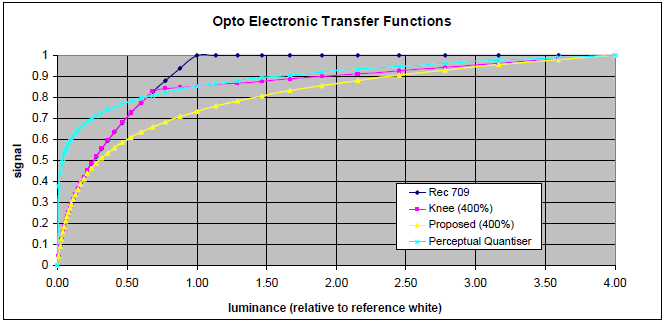There’s no question that High Dynamic Range (HDR) is a very hot topic. We’ve been tracking it in detail over the last year, especially after impressive demonstrations at IFA and IBC, reinforced by more at CES. At NAB, it was clearly the big issue in image quality. Our database shows more than 50 articles on DisplayDaily.com tagged with the term over the last 6 months.

There are a number of different technology solutions to delivering HDR content to the display. As always, content needs to be captured, stored, delivered and displayed in a standardised way to ensure the creative intent of the creator is maintained.
One of the most impressive systems for HDR is the Dolby Vision technology, which the company has developed for content creators, transmission and display. However, the best results are seen where the content is pre-processed and Dolby has worked with Hollywood studios and tool makers to enable Dolby Vision.
Dolby Vision uses either a single or a dual layer approach. In the single layer approach, there is no backward compatibility – the video stream cannot be correctly displayed by existing displays. Hence the alternative of the two layer approach, which allows a backwards compatible stream to run alongside a second layer which can be detected by new equipment and exploited to support new displays. (Technicolor has a broadly similar concept). In practice, the talk has been of a dual stream approach for broadcast as a completely new stream is not practical.
 The BBC, on the other hand, has a simpler concept and at the SES Industry Days, John Adam of Samsung promoted the idea for broadcasters and pointed out that the technology would allow implementation immediately.
The BBC, on the other hand, has a simpler concept and at the SES Industry Days, John Adam of Samsung promoted the idea for broadcasters and pointed out that the technology would allow implementation immediately.
For content that is, for example, created for the new Blu-ray UltraHD format, due around the end of this year, there is no problem to support the kind of dual layer approach proposed by Dolby. New BD-players can support the technology (or even a single stream approach).
However, broadcasters have to be able to support their existing installed base. Pay broadcasters can, at a high cost, think about upgrading their STBs, but public service broadcasters (PSBs) are very restricted in influencing the equipment in the home. On the other hand, PSBs would love to add HDR support to their broadcasts, not least because everybody agrees that HDR has an impact even on smaller and lower definition TVs, while there is still contention about the value of UltraHD resolutions on small sets.
The BBC approach to HDR is to replace the gamma of Rec. 709 (which defines the relationship between the signal input coming into the display and the brightness of the output) with a new Electrical Opto Transfer Function (EOTF) that “splices” a log-curve onto the “high end” of Rec. 709. There’s a white paper with more technical detail on the BBC R&D website. BBC OETF proposal (Dolby uses the PQ curve)
BBC OETF proposal (Dolby uses the PQ curve)
The BBC points out that the BT.709 gamma works pretty well at low to mid levels of brightness, as seen on traditional CRTs. However, to match the HDR TVs that are starting to be available, better performance at high brightness is needed. The BBC believes that its proposal would support displays up to around 5,000 cd/m² with 10 bit grey scale data (it also has a 12 bit proposal for content creation). (Adam said that 1,000 cd/m² is likely to be a practical maximum brightness for a while for consumer TVs)
There are some big advantages of the BBC proposal for broadcasters. First, no metadata is needed, which would be an advantage for live broadcast. Secondly, and this was being demonstrated by Samsung at the SES event last week, where an UltraHD HDR signal was being broadcast by SES and shown on one of its high end SUHD quantum dot/HDR TVs. The same signal was being run to an “off the shelf” UltraHD TV from Samsung’s 2014 range, demonstrating that the signal is compatible with both standard dynamic range and high dynamic range content. HDR Broadcast demonstration by SES & Samsung
HDR Broadcast demonstration by SES & Samsung
Now, the impact of the higher dynamic range was muted on the demonstration, but that was because the content had been graded for a relatively standard 600 cd/m² TV, rather than for the full potential of the 1,000 cd/m² peak brightness SUHD TV.
 Where content is graded for higher brightness (right), then the difference between standard and HDR sets is clear.
Where content is graded for higher brightness (right), then the difference between standard and HDR sets is clear.
A second demonstration, of content that had been graded for the brighter display, showed the full benefit and potential of the system, although that content was being run from separate media players to the two sets.
Now, I haven’t seen them side by side, and years of experience have told me that visual memory is very, very fallible, but I think that the demonstrations of the Dolby system have been more dramatic and spectacular than those of the BBC system. On the other hand, the BBC system is simple (relatively), uses a single backwards compatible stream and is available royalty free (we UK taxpayers fund the BBC’s R&D!) and that is bound to be compelling for broadcasters, especially PSBs in Europe.
It seems to me that a likely outcome in HDR is that there will be a split between the “ultimate performance” of, probably, the Dolby system at the high end, probably on packaged media and downloaded content and in cinemas if HDR projectors start to proliferate, while the BBC system might make it into broadcast, especially for the next phase of UltraHD development. The DVB is making decisions on its next developments shortly, so we’ll be watching with keen interest.
Bob

